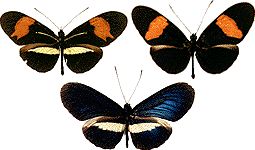Heliconius butterfly

In South America there are two species of Heliconius, both of which have multiple mimetic forms. The color patterns are controlled by many loci but in both species the loci are scattered at random among the chromosomes rather than in any linkage disequilibrium. When two morphs of a Heliconius species are crossed, the offspring contain a kaleidoscopic variety of non-mimetic recombinant forms that resemble neither parent nor any known morph of the species.
The reason for this is probably geographic. In Heliconius there is usually only one morph at any one place; the different morphs are geographically separated and will not interbreed in nature. The non-mimetic recombinant Heliconius is only generated when morphs from different places are put together in the laboratory. In Heliconius it does not matter if the mimicry genes are scattered around the chromosomes, because the non-mimetic progeny are not usually produced.
The genetics of Heliconius should be compared with that of another mimic, Papilio memnon.
The image opposite shows three variants of Heliconius erato.
| Next |



